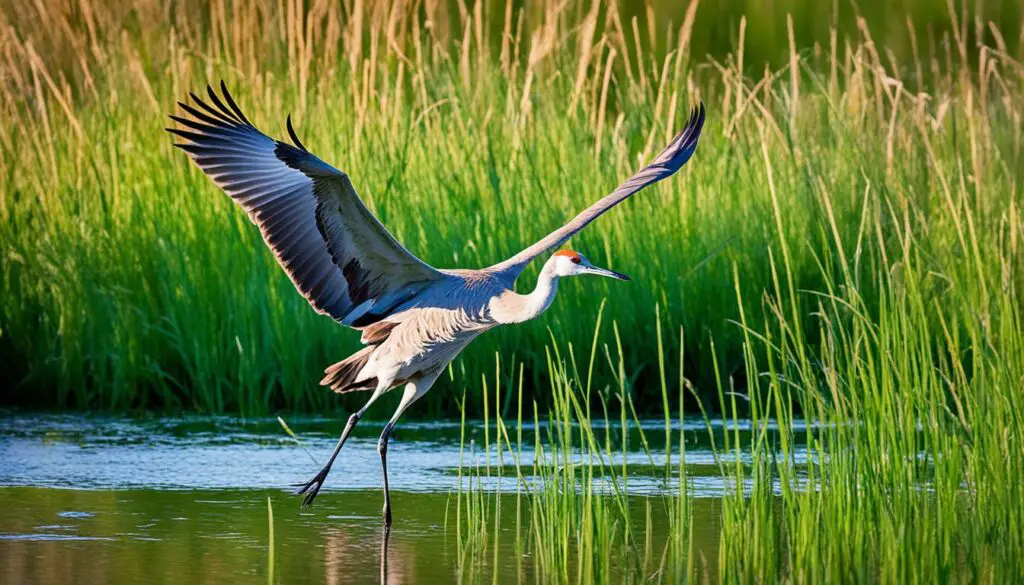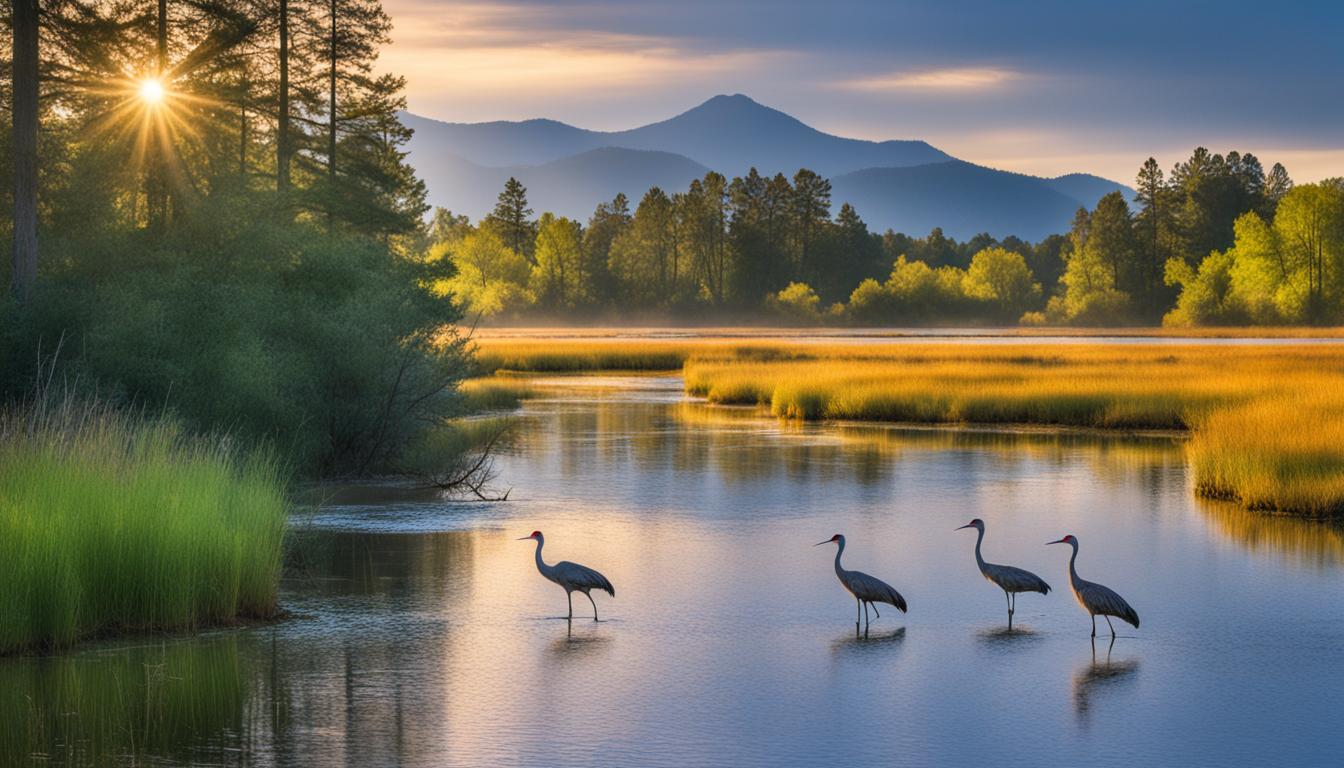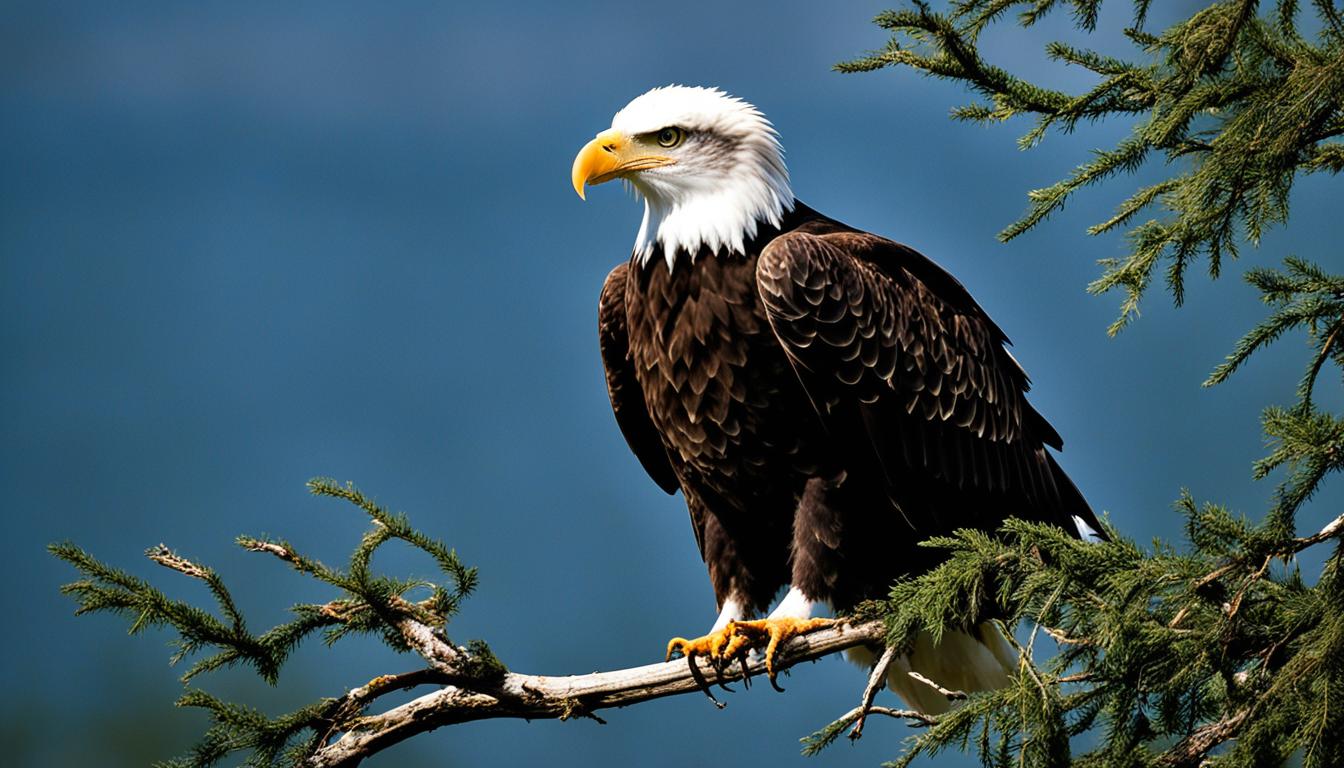Ever wondered why some wetlands are perfect for sandhill cranes? These birds love certain spots that help them live and make babies. They do well in many places, from marshes to prairies, if they have the right features. These include safe areas with water where they can nest. But what exactly does a perfect home look like for sandhill cranes? Let’s find out.
The birds often choose small wetlands far from big ones, or the edges of bigger ones. They pick spots with water to hide their nests in plants. Keeping these wetlands safe is important, whether the cranes stay all year or just visit. These spots are vital for their journeys too, where they meet up in large numbers.
Overview of Sandhill Crane Habitats
Sandhill Cranes love their homes, which change a lot throughout the year. They need certain types of places for each season. For example, they like big, wet areas with some plants around.
General Habitat Characteristics
The cranes look for places with lots of water and plants to make their nests. These areas should also provide food, places to mate, and safety. Choosing sandhill crane habitat wisely is crucial for their survival.
Knowing about the specific places sandhill crane like to nest is key to protecting them. These living areas are key to their life, supporting activities like eating and finding a mate.
| Habitat Type | Key Characteristics |
|---|---|
| Wetlands | Moisture-rich areas with abundant vegetation |
| Marshes | Standing water with plant diversity |
| Bogs | Saturated ground with shrubs and mosses |
Ideal Nesting Habitats for Sandhill Cranes
Sandhill crane nesting spots are crucial for them to have babies successfully. These big, beautiful birds look for lonely wetlands, marshes, bogs, and swales. They like to build their homes next to or in water, hidden by thick plants. Though some pick dry areas, most prefer these private, water-filled places.
The nests are made by both the male and female cranes. They pick the plants around them to make a safe spot for their eggs. This teamwork is key for keeping the eggs safe and warm. It shows how important the right kind of home is for sandhill cranes to start a family.
Sandhill cranes carefully choose where to lay their eggs. They want places that are safe from enemies and full of food for their babies. By selecting these perfect spots, they ensure they can live and raise their young without trouble.
Knowing what sandhill cranes need in a home helps us protect their living spaces. We must work to keep these important areas safe. This way, sandhill cranes will always have the right places to build their nests. And we can help keep their wonderful kind going strong for years to come.
The following table outlines specific characteristics of different nesting habitats:
| Habitat Type | Water Presence | Vegetation | Predator Protection |
|---|---|---|---|
| Isolated Wetlands | High | Tall grasses, cattails | High |
| Marshes | Moderate | Sedges, reeds | Moderate |
| Bogs | Low | Mosses, shrubs | Moderate |
| Swales | Variable | Mixed vegetation | Variable |
Breeding Season Habitat Preferences
Sandhill Cranes have favorite wetlands during their breeding season. These choices are key for saving these birds and their homes.
Types of Wetlands
Sandhill Cranes love areas like marshes, bogs, and wet meadows. These places are key for their survival and nesting need. They use plants like cattails and sedges for their nests. These wetlands are perfect for raising their young, offering good hiding spots and plenty of food.
Edge Habitats Between Wetlands and Uplands
The area where wetlands meet the high ground is also important. Known as edge habitats, these areas mix wet and dry land features. They’re perfect for finding food and building nests. Sandhill Cranes are drawn to these spots for these very reasons.
Nonbreeding Season Habitat Preferences
Sandhill cranes look for certain places during the nonbreeding season. They want areas that are good for finding food and a place to sleep. This helps us see the big picture of where sandhill cranes go in the winter.
Open Grassy Sites
During the nonbreeding season, open grassy sites are key for sandhill cranes. They spend a lot of time in these places, looking for seeds and bugs to eat. These sites not only give them plenty of food but also let them move around and see better, which helps keep them safe from animals that might want to eat them. This shows how flexible sandhill cranes are in picking their winter homes.
Roosting Sites in Rivers and Lakes
For a safe place to sleep, sandhill cranes pick rivers and lakes. These places help protect them from predators. The close connection between where they find food and where they sleep is very important. It means they can save energy by not traveling far between these areas. This closeness also ensures they have enough to eat and are safe all winter long.
Wintering Habitats in the Southern U.S. and Northern Mexico
Sandhill Cranes fly south to the warmer areas of the southern United States and northern Mexico in winter. These places vary to meet the many needs of these beautiful birds.
In the southern U.S., these cranes rest by shallow lakes and rivers at night. This water keeps them safe from predators. During the day, they look for food in pastures, grasslands, and fields where they find plenty of meals.
In northern Mexico, sandhill cranes also discover cozy winter spots. Rivers and lakes are crucial for resting. Fields and grasslands nearby are rich with food, helping cranes stay strong until it’s time to head north again.
Both these spots are just right for sandhill cranes. They can find all they need to survive the winter. Their ability to adapt in the U.S. South and northern Mexico keeps them going strong until it’s spring.
Sandhill Crane Habitat Characteristics
It’s crucial to know about the sandhill crane habitat characteristics for the birds’ well-being. They need places close to water. They also look for areas with the right plants for nesting and finding food.

Preferred Vegetation Types
Sandhill cranes like a mix of water-loving plants for their homes. They often choose to live near cattails, sedges, and other such plants. These plants are not just for shelter but also for making nests and finding food.
Distance to Water Sources
Being close to water is key for sandhill cranes. They usually pick places with water nearby for their nests. This water is important for their safety and finding food.
Food Sources Influence Habitat Selection
Sandhill cranes pick their homes based on what they eat. They munch on seeds, grains, bugs, and small animals. Where they find these foods affects where they choose to live, deciding their home.
Diet and Foraging Areas
These cranes can adapt where they look for food. They search in open areas, near water, and in fields. Fields after harvest are especially good, drawing cranes in fall and winter.
Knowing what sandhill cranes eat helps us see why they like some places more. The food and foraging areas are vital for their health all year and as they move around.
Impact of Habitat Loss on Sandhill Crane Populations
As sandhill crane numbers rise, the impact of habitat loss on sandhill cranes is clear. Destruction of wetlands and vital stopover points is a big threat. This affects the birds’ ability to migrate.
- Wetland Degradation: Losing wetlands where cranes nest, feed, and rest is dangerous. These places are essential for their life cycle. Any changes here can hurt their survival.
- Stopover Points: Sandhill cranes stop at key points to rest and eat during migration. Losing these places can harm their journey and health.
Special subspecies, like those in Mississippi and Cuba, are at greater risk. Keeping these subspecies alive means working hard to save their habitats. This shows how important conservation efforts are.
The need to protect sandhill crane habitats is urgent. It’s crucial for their survival in North America. The impact of habitat loss on sandhill cranes underlines this need.
Migratory Habits and Seasonal Habitat Use
Learning about sandhill crane movements sheds light on how they use habitats throughout the year. Every year, these grand birds fly a long way from the north to the south. They’re not just flying straight. They make key stops to rest and eat during this journey.
These resting spots are vital for the cranes. They are places with lots of food and few interruptions. Without these stops, their long flight would be much harder.
Sandhill cranes pick their path carefully. They choose areas with plenty of food and places to rest. Wetlands and farm fields become their homes for a short while, where they search for food. The places they pick are all about finding enough to eat and feeling safe.
The cranes’ choice of homes changes with the seasons. In spring and summer, they love the north’s marshes and wet meadows for making nests. But by fall, they fly to the south, looking for warmer places. Here, they find wetlands and lakes to feed and rest in. Understanding these moves is important for helping them survive all year.









